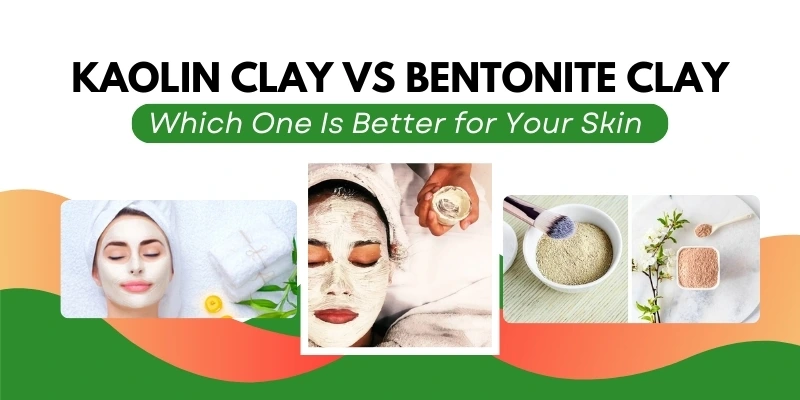
Kaolin Clay vs Bentonite Clay: Which One Is Better for You?
Clay masks are a timeless essential in skincare, known for their ability to cleanse, purify, and refresh the skin. They're both effective and natural, but with so many types of clays out there, it can be tough to decide which one is best for your skin. Kaolin clay vs bentonite clay —which one should you choose? Both clays have unique properties, but they serve different purposes depending on your skin type and skincare goals.
What Is Kaolin Clay?
Kaolin clay, often referred to as white clay, is a soft, finely textured substance known for its gentle touch on the skin. It’s rich in minerals and is especially popular for its soothing properties. Kaolin clay is often found in products for sensitive skin, as it provides a mild cleanse without stripping the skin’s natural moisture.
A major benefit of kaolin is its ability to absorb excess oil while still being gentle enough to avoid drying out the skin. For people with acne or oily skin, kaolin is a great option because it helps regulate oil production without causing irritation.
What Is Bentonite Clay?
Bentonite clay is a type of volcanic ash clay that has strong absorbing properties. It forms from the weathering of volcanic ash and is known for its ability to draw out toxins, impurities, and excess oils from the skin. This makes bentonite clay an excellent choice for oily and acne-prone skin types, as it can deeply cleanse and detoxify.
Its high pH level and swelling action allow it to deeply penetrate the skin, making it perfect for deep cleansing and pore-minimizing treatments. Bentonite clay is a go-to for people with congested skin, blackheads, and clogged pores.
Kaolin Clay vs Bentonite Clay: Texture and Sensitivity
One of the main differences between kaolin clay vs bentonite clay is the texture and how each clay interacts with the skin.
Kaolin Clay: Soft and silky, kaolin is considered the gentler option. It doesn't tighten the skin as much as other clays, making it ideal for those with sensitive or dry skin. It provides a mild exfoliation and deep cleanse without causing discomfort or excessive dryness.
Bentonite Clay: Bentonite clay has a more gritty, heavier texture. It can create a strong tightening sensation when applied to the skin, which is great for those looking to deeply cleanse and tighten their pores. However, it may be too intense for people with sensitive or dry skin.
Kaolin Clay vs Bentonite Clay: Which Is Best for Acne?
When it comes to fighting acne, both clays offer impressive benefits, but they work in different ways.
Kaolin Clay: This clay is great for mild acne or oily skin that is prone to occasional breakouts. It works by absorbing excess oil, reducing inflammation, and gently clearing pores. Kaolin clay is a wonderful option for those who need a soothing, non-stripping cleanse that won't aggravate sensitive skin or acne.
Bentonite Clay: Bentonite is the heavy hitter in the battle against acne. Its powerful detoxifying properties allow it to draw out impurities from the skin deeply, making it excellent for congested, acne-prone skin. Bentonite clay works well for those who experience regular breakouts, clogged pores, or blackheads, as it helps to detoxify and purify the skin more aggressively.
Kaolin Clay vs Bentonite Clay: Oil Control and Pore Minimizing
Both clays excel at oil control, but their effectiveness depends on your skin type.
Kaolin Clay: For those with oily or combination skin, kaolin clay works wonders by absorbing excess sebum without disrupting your skin's natural moisture balance. It keeps the skin matte and smooth, reducing the shine that often accompanies oily skin.
Bentonite Clay: Bentonite clay is a more potent choice for people with oily skin or enlarged pores. Its strong absorbing action helps control oil and tighten pores, making it ideal for those struggling with acne due to oil buildup.
Kaolin Clay vs Bentonite Clay: The Verdict for Sensitive Skin
If you have sensitive skin, it’s crucial to choose a clay that will cleanse without causing irritation.
Kaolin Clay: Kaolin is the better option for sensitive skin types, as it is gentle, non-irritating, and soothing. It’s unlikely to cause any redness or discomfort, making it perfect for those with rosacea, eczema, or skin conditions that require a delicate touch.
Bentonite Clay: While bentonite is effective for oily and acne-prone skin, it can be too strong for sensitive skin types. It may cause redness, tightness, or irritation if left on too long or used too frequently.
How to Use Kaolin Clay and Bentonite Clay
Kaolin Clay: To use kaolin clay, mix it with water, rose water, or aloe vera gel to form a smooth paste. Apply to the skin for 10–15 minutes, then rinse off with lukewarm water. Kaolin clay works best when used 2–3 times a week for regular oil control and skin balancing.
Bentonite Clay: For bentonite clay, mix it with water or apple cider vinegar to form a paste. Apply it to your face for 10–20 minutes, then rinse off with warm water. You may feel a strong tightening sensation, but this is part of the clay's detoxifying process.
Which Clay Is Right for You?
So, which clay should you choose: kaolin clay vs bentonite clay?
Choose Kaolin Clay if: You have sensitive skin, dry skin, or occasional breakouts. Kaolin is perfect for oil control without being harsh, offering a gentle but effective skincare solution.
Choose Bentonite Clay if: You have oily or acne-prone skin, large pores, or are looking for a more intense detox. Bentonite clay’s deep-cleansing properties will help minimize pores, reduce oil, and prevent future breakouts.
Conclusion:
Whether you choose kaolin clay vs bentonite clay ultimately depends on your skin type and skincare needs. Both offer incredible benefits, but understanding your skin’s unique requirements will help you make the right choice. Kaolin clay is gentler and ideal for sensitive skin, while bentonite clay is perfect for deep cleansing and oil control.